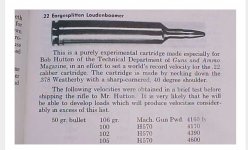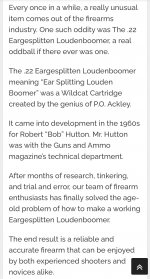Let's review.
The US Army Marksmanship Unit shoots in the annual Interservice Rifle Championships at Quantico, Virginia, and the National Matches at Camp Perry, Ohio.
There are two long-range rifle divisions: Service Rifle and Match Rifle / Unlimited.
Service Rifle until 2015 required an iron-sight M1, M14, M16, or SR-25 / AR-10. In 2016 4.5X telescopes were authorized.
Match Rifle / Any-Rifle included bolt actions and magnums. There are iron-sight days and iron-sight matches, and any-sight (telescope) matches. There are no caliber restrictions so military and service teams have used high-velocity cartridges to minimize wind dispersion, to include the 30-338 Magnum, the 300 Winchester Magnum, 7mm Magnums, and the 6.5 x 284.
Special Forces had requirements for long-distance target penetration / defeat and had pretty much centered capability on the 300 Winchester Magnum. The Special Forces Target Interdiction Course starting in 1984/85 was the foundational ARSOF sniper training outside of sending instructors to Quantico to the Marine Scout-Sniper
Instructor Course.
There was
NO established central United States Army sniper course after Vietnam. Sniper courses were generally conducted by the Army Marksmanship Unit and the Major Command, Numbered Army, regional, division, and post Marksmanship Training Units (MTUs). Those were pretty much deactivated, with XVIIIth Airborne Corps' MTU closing in 1985, their gear declared excess and transferred to SOTIC.
There was NO Army Sniper School after Vietnam until 1987. The Standard-A sniper rifle until 1988 was the M-21 with ART II scope (while the USAMU still had the ART 1 at Fort Benning through at least 1983).
SOTIC was commanded by Captain John Stanley. Master Sergeant Rick Boucher (later a Civil Service sniper instructor) represented SOTIC as one of SF's technical reps in the negotiations with Leg Army trying to get a standard bolt rifle into system (as opposed to SF's older McMillans, 700s, and 40Xs).
SF wanted 300 Winchester Magnum. Leg Army wanted 7.62 Match. THERE WAS NO REQUIREMENT FOR 30-06 MATCH -- A DEAD CARTRIDGE. Big Army compromised on the long action (if SF wanted 300 Win Mag, they could use new USSOCOM money authorized under MFP-11 funding created under the 1987 Nunn-Cohen Act which formed combatant commands, the United States Special Operations Command, and Special Forces as a separate Army branch).
The authors of that Rifle Shooter article are full of shit. As they say in mathematics, "Show your work." In law, "Present your case and evidence."
Rick is retired and still very much alive.
The Army's sniper school was established in 1987. This article's author (the Fort Benning Historian) just happens to be one of my running buddies. Link: A Short History of Army Snipers and the U.S. Army Sniper Course 





